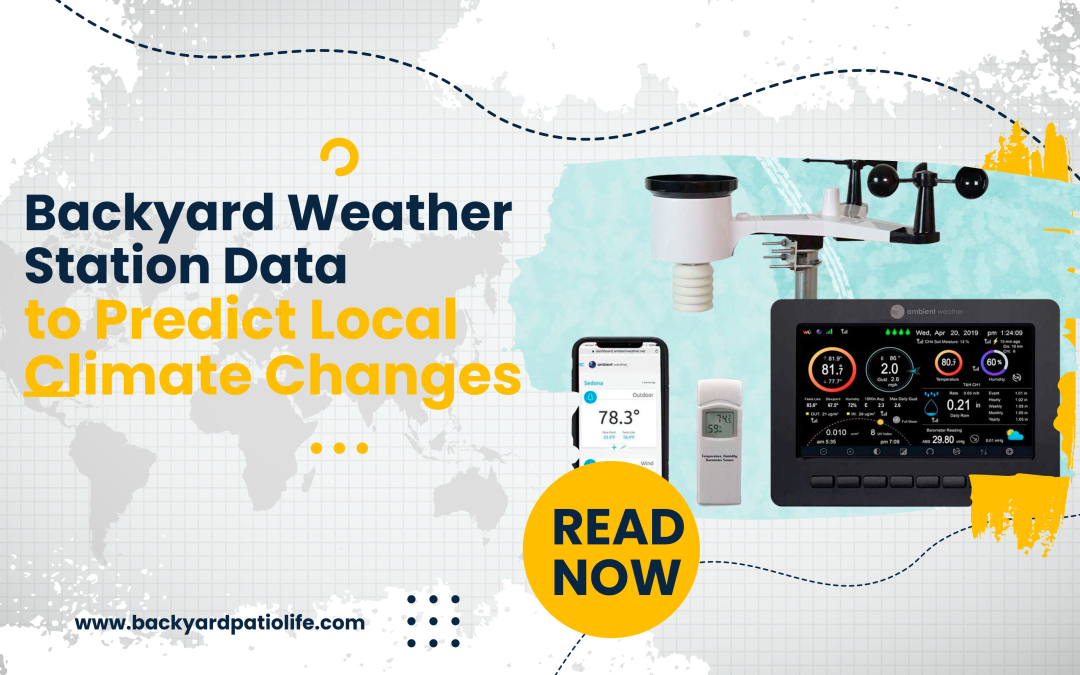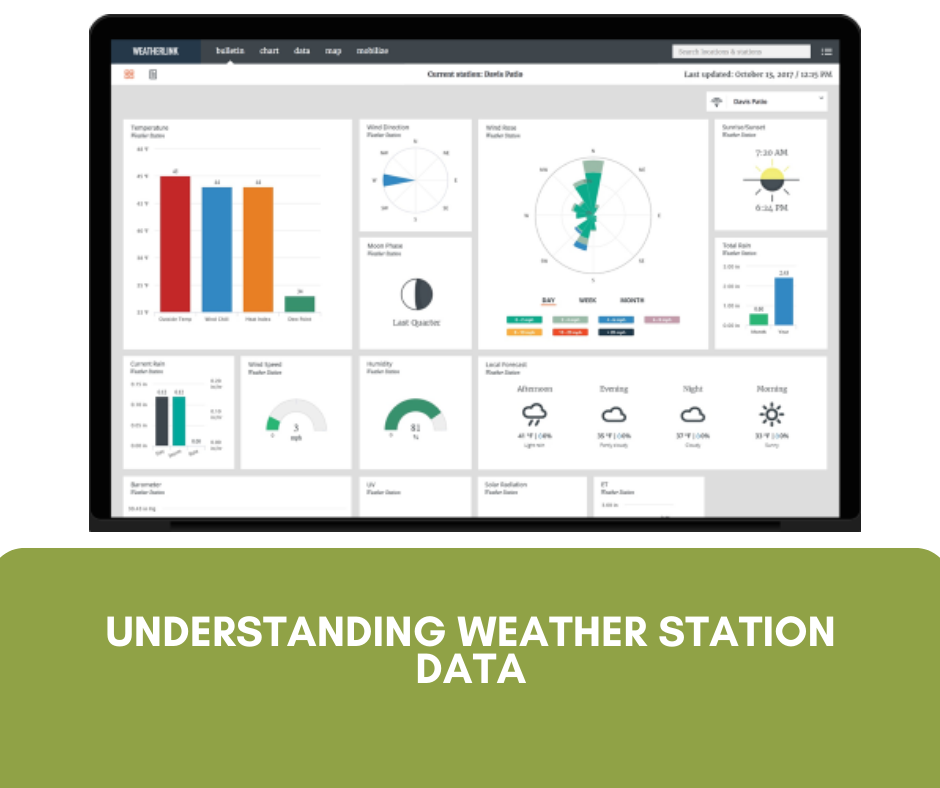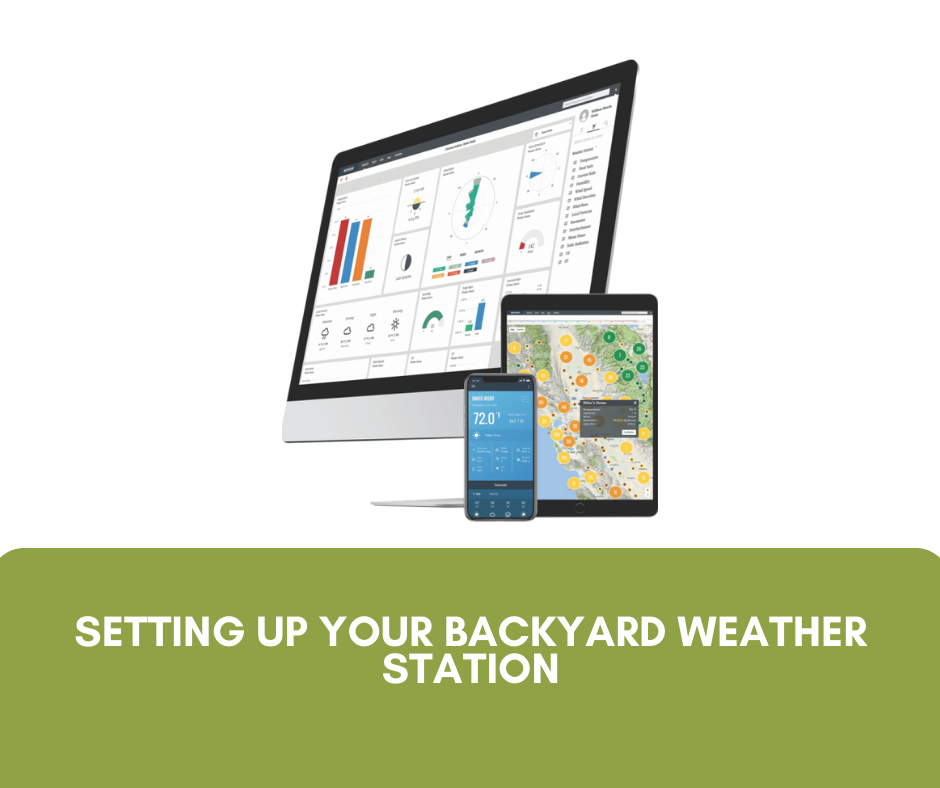==================
A Caveat and Affiliates
First off, a little caveat: within my articles you will find affiliate links, meaning if you buy them, I get a small commission. Your cost is not affected. In addition, I am an Amazon Associate and I earn from qualifying purchases on Amazon.
And yes, if I say that I recommend a product here, it means I truly believe it is a good product. I refuse to recommend any product that I have not researched and believe to be a good value.
Even better, I provide you with a very clear picture of the product, it’s use, and the probable value.
Earning your trust is important to me. I run this website myself and the commissions and donations help support the site.
Sound reasonable and fair enough? Let’s continue to the article.
==================
Do you know how the weather works right in your backyard? In this article, we’ll talk about how to use backyard weather station data to predict local climate changes.
These powerful tools are more than just gadgets. They’re your personal window into understanding and predicting local weather patterns. Keep reading to discover simple, effective ways to track and analyze data that can reveal surprising insights about your local environment.
Weather enthusiasts and hobbyists often look to the skies with keen interest, and with a backyard weather station, you can transform this interest into informative data that aids in forecasting weather phenomena and events. Gathering data from your backyard gives you the unique advantage of tracking hyperlocal climatic changes. This is crucial since weather can vary significantly over small distances and different terrains.
Your personal weather station can monitor a variety of meteorological parameters such as temperature, humidity, barometric pressure, wind speed, and rainfall. This collected data, over time, becomes a robust source of information, making it possible to observe trends and make more accurate predictions about the weather in your local area.
Understanding the technology and data available through your weather station is the first step toward making informed forecasts. You cultivate a precision toolset for intercepting nature’s signals by setting up and properly maintaining your equipment.
Monitoring and interpreting this data allows you to predict weather events such as storms, heat waves, or cold fronts before they occur. Furthermore, incorporating advanced technology like software that analyzes and visualizes weather patterns can significantly enhance the reliability of your forecasts.
Sharing your findings with the community contributes to broader weather understanding and connects you with a network of local and professional meteorologists. Engagement with these communities furthers your knowledge and adds depth to your weather predictions as you learn from the collective experience. In essence, your backyard weather station can be the gateway to becoming an active participant in the larger conversation about weather forecasting and climate patterns.
Key Takeaways
- Your backyard weather station data is essential for making localized weather forecasts.
- Proper setup and interpretation of weather data are key to predicting events with accuracy.
- Sharing your insights contributes to and benefits the wider meteorological community.
Understanding Weather Station Data
Your ability to forecast weather phenomena hinges on the precise understanding of data from your backyard weather station. Each sensor plays a vital part in painting the overall picture of your local weather conditions.
Types of Sensor Data
Your weather station collects a variety of sensor data to help you understand the environment:
- Temperature Sensors – Measure the air temperature.
- Humidity Sensors – Indicate the amount of moisture in the air.
- Barometric Pressure Sensors – Provide insight into weather patterns by measuring atmospheric pressure.
- Wind Speed and Direction Sensors – Capture the wind’s behavior, which is crucial for predicting storm systems.
- Rain Gauges – Record rainfall, helping to determine precipitation amounts and intensity.
- Solar Radiation Sensors – Track the intensity of the sun’s rays, which can affect temperature and weather changes.
Data Accuracy and Calibration
The accuracy of your data is paramount. Without it, forecasts become unreliable. Ensure your weather station is:
- Properly Calibrated – Regular calibration maintains the precision of sensor readings.
- Correctly Positioned – Placement away from obstructions and reflective surfaces prevents skewed results.
- Regularly Maintained – Keep sensors clean and free of debris to prevent inaccurate data due to blockages or damage.
By closely monitoring the accuracy and calibration of your weather station, you can rely on your data for precise weather prediction.
Credits: Life Science Centre
Setting up Your Backyard Weather Station
Proper setup is crucial to forecast weather events using your backyard weather station accurately. This involves choosing a strategic location and following specific installation guidelines.
Choosing the Right Location
- Avoid Obstructions – To prevent data distortion, place your station away from buildings and trees.
- Consider Height – For wind measurements, the anemometer should be positioned at least 33 feet above the ground to reduce turbulence influence.
Installation Tips
- Secure Firmly – Ensure the weather station is mounted on a stable surface to avoid displacement by wind or animals.
- Direction Matters – Align the rain gauge and wind vane to true north for accurate readings, as suggested in guidelines from Weather Underground.
Interpreting Weather Data
Accurate weather forecasting hinges on your ability to interpret data from your backyard weather station. Here’s how you can read and understand key measurements to predict weather conditions.
Reading Temperature Trends
Temperature fluctuations can give you valuable insights into weather patterns. By examining daily temperature variances, you can predict if the day will be unusually warm or cool.
For example, increasing night temperatures might indicate a warm front approaching. It’s essential to consider both diurnal variations and seasonal trends when assessing temperature data.
Analyzing Atmospheric Pressure
Atmospheric pressure changes are indicative of impending weather events. A steady decrease in pressure often precedes stormy weather, while rising pressure suggests clearer skies ahead. Keep an eye on your station’s barometer and note whether the pressure is falling rapidly or holding steady.
Deciphering Humidity Levels
Humidity levels are directly linked to the comfort and precipitation likelihood. High humidity can suggest the potential for rain, particularly if paired with other indicators like cloud cover and pressure changes.
Conversely, low humidity often correlates with drier conditions. Your weather station’s hygrometer readings are critical for interpreting this aspect.
Wind Speed and Direction
The direction and speed of the wind can signal changes in weather. For example, a sudden shift to easterly winds might bring different weather patterns, depending on your location.
Increasing wind speed could also warn of an oncoming storm. Monitoring these metrics from your weather station’s anemometer allows for more informed predictions.
Creating a Weather Forecast
To accurately forecast the weather using your backyard weather station, you need to synthesize data, identify patterns, and apply forecast models.
Synthesizing Data Points
Your weather station provides a range of data points such as temperature, humidity, wind speed, and barometric pressure. Collecting this data consistently over time is vital. You’ll want to record these measurements at regular intervals to establish a comprehensive dataset, which is instrumental in predicting weather events.
Identifying Weather Patterns
Observing changes in your data can help you spot weather patterns. For example, a drop in barometric pressure often indicates an approaching storm. Regularly comparing your local data with regional weather information can sharpen your ability to predict small-scale weather changes in your vicinity.
Utilizing Forecast Models
Once you have a robust set of data, you can leverage forecast models. These are algorithms and equations used by meteorologists to predict weather. Simple models might examine temperature trends to predict frost, while more complex models could help you understand the probability of precipitation based on cloud cover and humidity levels.
Tracking and Recording Weather Events
Effective weather forecasting relies on diligent tracking and recording of weather data. Your backyard weather station provides the opportunity to gather information about local weather conditions, which can be invaluable in anticipating and understanding weather phenomena.
Maintaining a Weather Log
Keep a daily log of weather observations, including temperature, humidity, barometric pressure, wind speed, and precipitation. Utilize a spreadsheet or a dedicated weather journal to record these measurements at regular intervals, ideally at the same time each day. This consistent approach will yield a comprehensive dataset over time, helping you to detect patterns and anomalies.
- Temperature and Humidity – Record the daily high, low, and average readings.
- Barometric Pressure – Note any significant changes, as these can indicate weather fronts moving in.
- Wind Speed and Direction – Document any unusual wind activity that may precede a change in weather.
- Precipitation – Measure rainfall or snowfall amount and type, including any instances of hail or sleet.
Highlighting Significant Weather Events
Flag extreme weather events in your log for further study. These events could include rapid temperature changes, unusually high winds, or significant precipitation. Linking these occurrences with large-scale weather maps and forecasts from the National Weather Service can help you understand their causes and potential effects.
- Severe Weather – Clearly mark the date and details of occurrences such as thunderstorms, blizzards, or heatwaves.
- Unusual Patterns – Note any long-term deviations from average conditions, as they can be an early warning sign of more dramatic weather events or seasonal shifts.
Enhancing Forecasts with Technology
Leveraging technology greatly improves the accuracy and utility of weather predictions from your backyard weather station. Today’s advancements offer a plethora of sophisticated options for enthusiasts and professionals alike to refine forecasting methods.
Software Tools
With modern software tools, your weather station data becomes more insightful. For instance, these tools can process and analyze atmospheric conditions to predict weather events with greater precision. Solutions like the system provided by Popular Science demonstrate how software can take readings every few seconds and use them, along with additional factors like barometric pressure, to forecast upcoming weather changes.
Mobile Applications
Mobile applications turn your smartphone into a powerful weather-forecasting device. These apps can seamlessly connect with your weather station, offering real-time data analysis and predictions accessible from anywhere. They often include customizable alerts, informing you about the weather conditions relevant to your location.
Online Resources
Lastly, utilize online resources to supplement the data from your weather station. Authoritative sites, such as those run by NOAA, provide access to large datasets, radar images, and professional forecasts. By comparing your local data with these broader resources, you can gain a more holistic view of weather patterns and enhance your own forecasting abilities.
Sharing Your Weather Insights
With a personal weather station in your backyard, you can contribute valuable data to larger forecasting efforts and engage with local and global weather communities.
Community Networks
By participating in community networks like the National Weather Service, your weather data becomes part of a larger database meteorologists and researchers use to predict weather patterns more accurately. Ensure a dedicated internet connection to share your data in real time, providing insights that can lead to more accurate and localized weather forecasts.
- Local Impact – Your data aids in enhancing the precision of region-specific models.
- Research Support – Contribute to scientific studies on climate trends and weather predictions.
Social Media
Leverage platforms like Facebook, Twitter, or Instagram to share insights from your weather station. By doing so, you can educate and inform your followers about impending weather conditions, fostering a community of weather-aware individuals.
- Post real-time updates to keep your local community informed.
- Use hashtags to increase visibility and engage with a wider audience.
Timely Alerts – Social media posts can immediately warn about sudden weather changes.
Visual Content – Share graphs and charts from your weather data for clarity.
Continuous Learning and Improvement
To harness the full potential of your backyard weather station, ongoing engagement with meteorological education and practice is essential. This engagement ensures that you refine both your data collection methods and interpretation skills for more accurate weather predictions.
Staying Informed with Meteorological Research
You should regularly check the latest advancements in meteorology. Keeping up-to-date with current research allows you to adapt your practices to include new findings.
A well-informed weather enthusiast can more accurately interpret patterns and phenomena observed in their local data. Explore academic journals or online resources such as the Backyard Weather Station – Activity – TeachEngineering to get acquainted with the latest industry standards and research.
Attending Workshops and Webinars
Workshops and webinars provide practical knowledge and networking opportunities that are invaluable for skill enhancement. Look for events that focus specifically on using weather station data for forecasting.
By attending these sessions, you can learn new techniques, understand complex meteorological concepts, and raise your weather forecasting acumen. Utilize platforms like TeachEngineering to find relevant events focused on educational growth.
Wrapping It Up
Your backyard weather station is more than just a tool. It’s a step towards understanding our changing climate. By collecting local data, you’re contributing to a larger picture, helping to predict local climate changes.
It’s empowering to know that, from your own backyard, you can make a meaningful impact. So, keep tracking, keep learning, and most importantly, keep sharing your findings!
FAQs
What weather variables are critical for forecasting local weather events?
Key variables include temperature, humidity, barometric pressure, wind speed and direction, and rainfall. Monitoring these weather station components can help you foresee local weather changes.
Which methods are most effective for analyzing weather station data to predict weather changes?
Comparative analysis over time periods and pattern recognition are the most effective. You can assess trends and sudden changes that often precede weather events.
How does the integration of various personal weather station data improve forecasting accuracy?
When data from multiple sources is pooled, it creates a more complete picture of the local climate. This combined approach can improve computer model data, enhancing forecast precision.
How do you properly place a weather station for the most accurate readings?
By providing real-time, local data, personal weather stations allow for a more nuanced understanding of micro-climates. This is invaluable for accurate local weather forecasts.
What role do home weather stations play in enhancing the precision of national weather service forecasts?
Home stations offer ground-truth data to national services, verifying and refining model predictions. Your data contributions can improve weather forecasts for your area.
How can individuals utilize weather station data for personal weather predictions?
You can predict upcoming conditions by correlating past weather events with current data. Tools like Weather Underground’s guide can help you interpret and apply your data effectively.
Learn More About Your Backyard Weather Station!
Join our online community, and let’s monitor the weather together! Discover the precision, insights, and fascination that come with owning a backyard weather station. Embrace the excitement and discovery that awaits you in your own backyard.
Follow us on Facebook, Instagram, and Twitter, and let’s share our weather observations and experiences!
Facebook: https://www.facebook.com/BackYardPatioLife/
Instagram: http://instagram.com/backyardpatio_life
Twitter: https://twitter.com/happybackyard
Happy Weather Watching!






